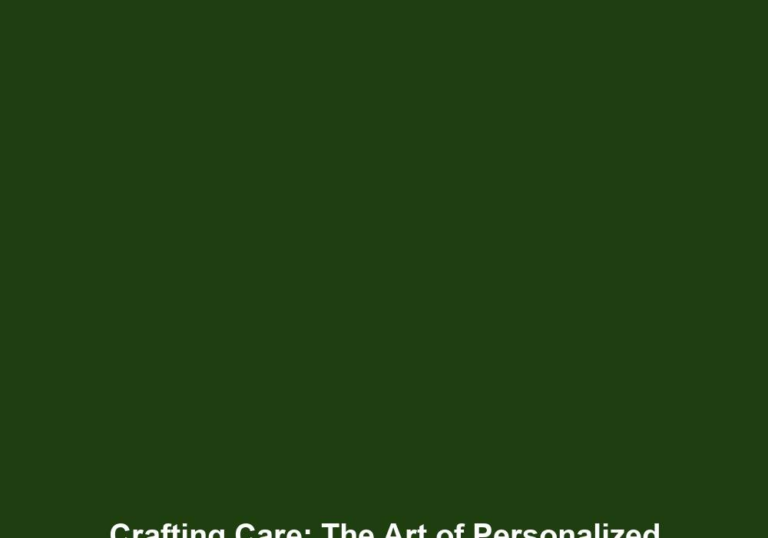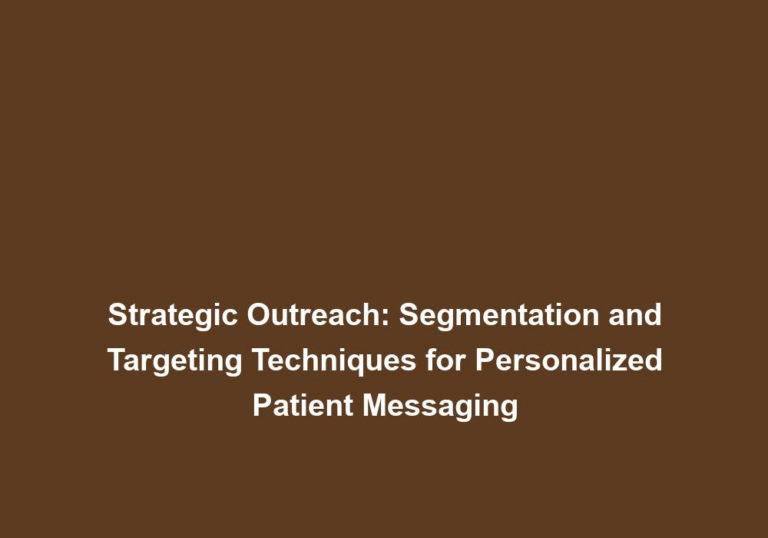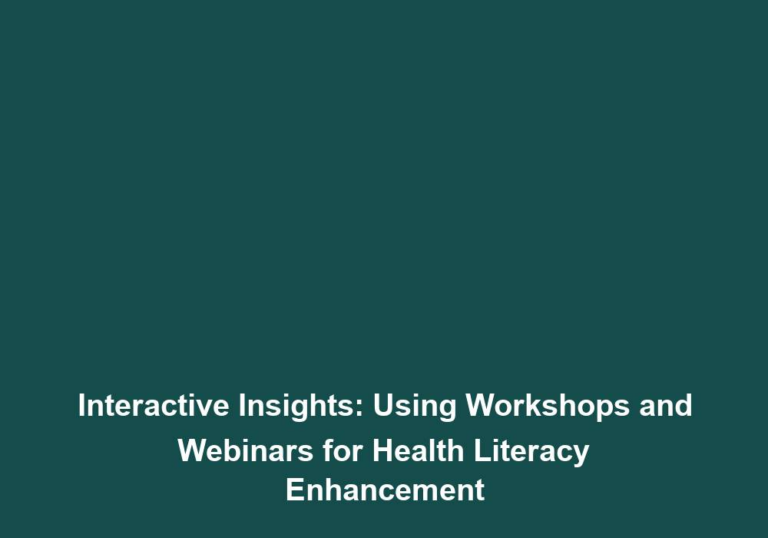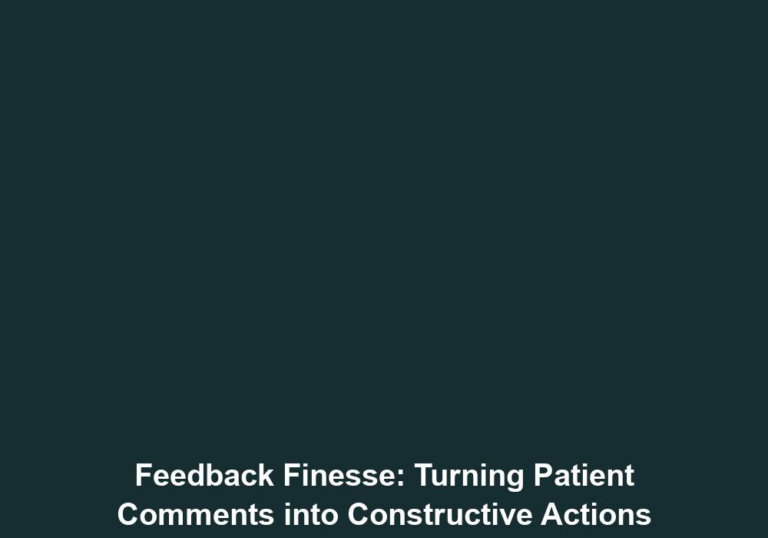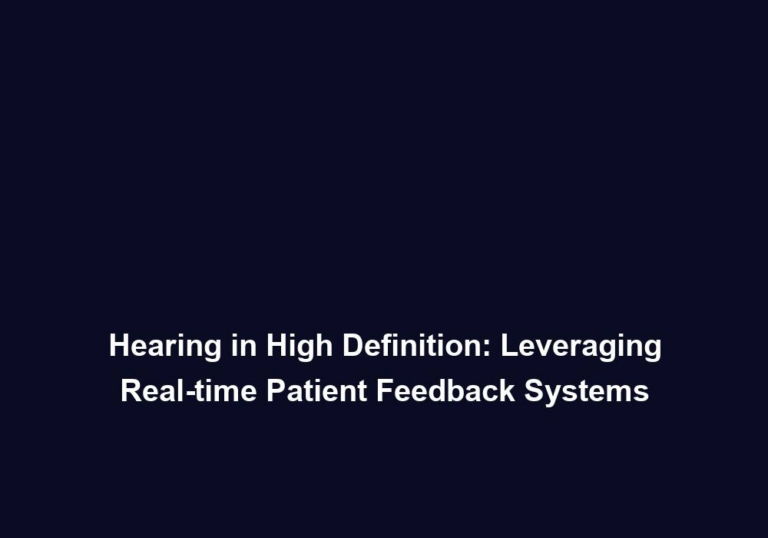Messages that Matter: Tailoring Communication to the Patient’s Needs
Effective communication in healthcare is crucial for providing quality patient care and improving patient outcomes. However, not all communication strategies are created equal. To ensure personalized care and foster patient engagement, it is essential to tailor communication to the patient’s needs. In this article, we will explore the importance of messages that matter and discuss various strategies to enhance communication in healthcare settings.
Why Messages Matter in Healthcare
Communication plays a pivotal role in healthcare as it serves as the foundation for building trust, establishing rapport, and ensuring patients’ understanding of their conditions and treatment plans. Messages that matter encompass delivering information in a clear, concise, and empathetic manner, while also adapting communication styles to meet patients’ needs and preferences.
When healthcare professionals communicate effectively, patients feel heard, valued, and more engaged in their care. This, in turn, leads to improved patient satisfaction, adherence to treatment plans, and better health outcomes. On the contrary, poor communication can result in confusion, anxiety, and noncompliance, hindering the delivery of optimal care.
Understanding the Patient’s Needs
To tailor communication effectively, healthcare providers must first understand the individual needs of each patient. Patients come from diverse backgrounds, cultures, and have varying levels of health literacy, all of which influence their comprehension and preferences for communication styles. Here are some key factors to consider:
Language and Health Literacy
Language barriers and health literacy levels can significantly impact communication. Healthcare professionals should identify patients’ preferred language and assess their understanding of medical terminology. Simplifying complex medical jargon and utilizing plain language can enhance comprehension and empower patients to actively participate in their care. Some strategies to consider include:
- Providing written materials, such as brochures or pamphlets, in the patient’s preferred language to supplement verbal explanations.
- Using visual aids, such as diagrams or charts, to convey information in a more accessible format.
- Encouraging patients to ask questions and clarifying any terminology they may not understand.
Cultural Considerations
Culture shapes patients’ beliefs, values, and attitudes towards healthcare. Recognizing and respecting cultural differences is crucial to establish trust and avoid misunderstandings. Healthcare providers should consider cultural norms, beliefs, and communication styles when tailoring messages to meet patients’ needs. Some strategies to promote cultural sensitivity include:
- Taking the time to learn about different cultures and their healthcare practices.
- Avoiding assumptions and generalizations based on cultural backgrounds.
- Adapting communication styles to align with cultural preferences, such as using appropriate greetings or gestures.
Emotional State
Patients often experience heightened emotions, such as fear, anxiety, or frustration, during healthcare encounters. Acknowledging and addressing these emotions is essential to build rapport and ensure effective communication. Demonstrating empathy, active listening, and providing emotional support can lessen patient distress and foster a more collaborative relationship. Consider the following strategies:
- Validating the patient’s emotions and creating a safe space for them to express their concerns.
- Offering reassurance and empathy through verbal and non-verbal cues.
- Providing resources for emotional support, such as counseling services or support groups.
Preferred Learning Style
Each patient has a unique learning style, whether they are visual, auditory, or kinesthetic learners. Identifying patients’ preferred learning style can help healthcare professionals choose appropriate communication methods. For instance, visual learners may benefit from diagrams or visual aids, while auditory learners may prefer verbal explanations. Consider the following strategies:
- Incorporating visual aids, such as diagrams, charts, or videos, to supplement verbal explanations.
- Providing written materials or handouts that patients can refer to for reinforcement.
- Offering demonstrations or hands-on activities to cater to kinesthetic learners.
Strategies for Tailoring Communication
Now that we understand the importance of messages that matter and the patient’s needs, let’s explore some strategies to enhance communication in healthcare:
1. Active Listening
Active listening involves paying full attention to the patient, focusing on their verbal and non-verbal cues. By listening attentively, healthcare professionals can gain valuable insights into the patient’s concerns, needs, and preferences. Active listening also creates a safe space for patients to share their experiences, fostering trust and engagement. Some techniques for active listening include:
- Maintaining eye contact and using affirmative gestures to show interest.
- Reflecting back on what the patient has said to ensure understanding.
- Avoiding interruptions and allowing the patient to fully express themselves.
2. Use Plain Language
Avoid using medical jargon and complex terminology when communicating with patients. Instead, use plain language that is easy to understand, regardless of the patient’s health literacy level. Explain medical concepts in simple terms and encourage patients to ask questions to ensure comprehension. Some tips for using plain language include:
- Breaking down complex information into smaller, digestible chunks.
- Using analogies or metaphors to explain medical concepts in relatable terms.
- Checking for understanding by asking patients to rephrase the information in their own words.
3. Empathy and Emotional Support
Show empathy towards patients by validating their emotions and recognizing the challenges they may be facing. Acknowledge their fears and concerns, and provide emotional support throughout the healthcare journey. Building a compassionate and trusting relationship can greatly enhance communication and patient satisfaction. Consider the following strategies:
- Using empathetic statements and expressions to convey understanding and support.
- Encouraging patients to share their feelings and concerns openly.
- Providing resources or referrals for additional emotional support, such as counseling services.
4. Visual Aids and Written Materials
Utilize visual aids, such as diagrams, charts, or videos, to supplement verbal explanations. Visual aids can enhance understanding, particularly for visual learners. Additionally, providing written materials, such as brochures or pamphlets, can serve as valuable resources for patients to refer to later. Consider the following strategies:
- Creating visually appealing and easy-to-understand diagrams or infographics.
- Using videos or animations to demonstrate procedures or treatment plans.
- Offering written materials that summarize key points or instructions.
5. Cultural Sensitivity
Be mindful of patients’ cultural backgrounds and adapt communication styles accordingly. Respect cultural norms and beliefs, and avoid making assumptions. Taking the time to learn about different cultures and their healthcare practices demonstrates respect and fosters effective cross-cultural communication. Consider the following strategies:
- Learning basic greetings or phrases in different languages to create a welcoming environment.
- Seeking guidance from cultural consultants or interpreters when needed.
- Being open-minded and receptive to different perspectives or beliefs.
6. Encourage Questions and Active Participation
Create an open and non-judgmental environment that encourages patients to ask questions and actively participate in their care. Address any misconceptions or doubts they may have and involve them in shared decision-making. Engaged patients are more likely to adhere to treatment plans and actively manage their health. Consider the following strategies:
- Welcoming questions and actively listening to patients’ concerns.
- Providing clear explanations and options for treatment or care decisions.
- Collaborating with patients to develop personalized care plans based on their preferences and goals.
7. Follow-Up and Feedback
After communicating with patients, follow up to ensure their understanding and address any additional questions or concerns. This demonstrates a commitment to their well-being and provides an opportunity for patients to provide feedback. Feedback can help healthcare providers improve their communication skills and enhance the patient experience. Consider the following strategies:
- Scheduling follow-up appointments or phone calls to check on patients’ progress.
- Sending educational materials or resources related to their condition or treatment.
- Requesting feedback through surveys or patient satisfaction questionnaires.
Conclusion
Effective communication in healthcare is a powerful tool in delivering patient-centered care. By tailoring messages to meet the patient’s needs, healthcare professionals can foster engagement, improve patient satisfaction, and enhance health outcomes. Understanding the patient’s language, culture, emotional state, and preferred learning style are key factors in tailoring communication. By employing strategies such as active listening, using plain language, and providing visual aids, healthcare providers can build trust, promote understanding, and create meaningful connections with their patients.



